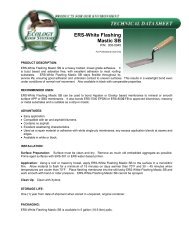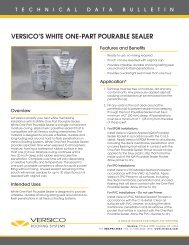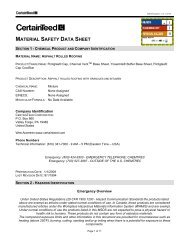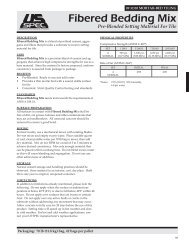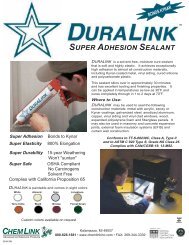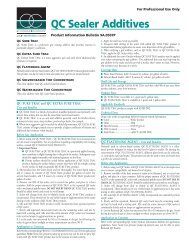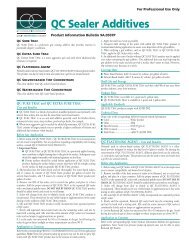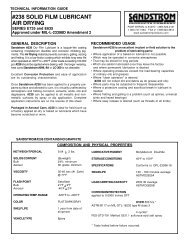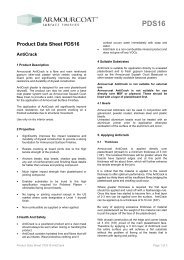Simpson Anchors - Anchoring and Fastening Systems - BuildSite.com
Simpson Anchors - Anchoring and Fastening Systems - BuildSite.com
Simpson Anchors - Anchoring and Fastening Systems - BuildSite.com
Create successful ePaper yourself
Turn your PDF publications into a flip-book with our unique Google optimized e-Paper software.
C-SAS-2009 © 2009 SIMPSON STRONG-TIE COMPANY INC.<br />
EPOXY-TIE ®<br />
Injection Guide<br />
Important: These instructions are intended as re<strong>com</strong>mended guidelines. Due to the variability of fi eld conditions,<br />
selection of the proper material for the intended application <strong>and</strong> installation are the sole responsibility of the applicator.<br />
Epoxy injection is an economical method of repairing non-moving cracks<br />
in concrete walls, slabs, columns <strong>and</strong> piers <strong>and</strong> is capable of restoring the<br />
concrete to its pre-cracked strength. Prior to doing any injection it is<br />
necessary to determine the cause of the crack. If the source of cracking<br />
has not been determined <strong>and</strong> remedied, the concrete may crack again.<br />
Materials<br />
• ETI-LV for repair of fi ne to medium-width cracks<br />
(Suggested width range: ¹⁄₆₄"–¹⁄₄").<br />
• ETI-GV for repair of medium-width cracks<br />
(Suggested width range: ³⁄₃₂"–¹⁄₄")<br />
• Crack-Pac ® injection epoxy for repair of fi ne to medium non-structural<br />
cracks (Suggested width range: ¹⁄₆₄"–¹⁄₄")<br />
• CIP, CIP-F <strong>and</strong> ETR are re<strong>com</strong>mended for paste-over of crack surface <strong>and</strong><br />
installation of injection ports. ET, EDOT , ETR or SET adhesives may also<br />
be used as a substitute. (SET is the only paste-over epoxy approved for<br />
NSF/ANSI St<strong>and</strong>ard 61.)<br />
• E-Z-Click injection ports, fi ttings <strong>and</strong> other suitable accessories.<br />
Preparation of the Crack for Injection<br />
Clean the crack <strong>and</strong> the surface surrounding it to allow the epoxy to bond to<br />
sound concrete. At a minimum, the surface to receive paste-over should be<br />
brushed with a wire brush. Oil, grease or other surface contaminates must<br />
be removed in order to allow the paste-over to bond properly. Take care<br />
not to impact any debris into the crack during cleaning. Using clean, oil free<br />
<strong>com</strong>pressed air, blow out the crack to remove any dust, debris or st<strong>and</strong>ing<br />
water. Best results will be obtained if the crack is dry at the time of injection.<br />
If water is continually seeping from the crack, the fl ow must be stopped in<br />
order for epoxy injection to yield a suitable repair. Other materials such as<br />
polyurethane resins may be required to repair an actively leaking crack.<br />
For many applications, additional preparation is necessary in order to seal<br />
the crack. Where a surfacing material has been removed using an acid or<br />
chemical solvent, prepare the crack as follows:<br />
1. Using clean, <strong>com</strong>pressed air, blow out any remaining debris <strong>and</strong> liquid.<br />
2. Remove residue by high-pressure washing or steam cleaning.<br />
3. Blow any remaining water from the crack with clean <strong>com</strong>pressed air.<br />
If a coating, sealant or paint has been applied to the concrete it must be<br />
removed before placing the paste-over epoxy. Under the pressure of injection<br />
these materials may lift <strong>and</strong> cause a leak. If the surface coating is covering<br />
the crack, it may be necessary to route out the opening of the crack in a “V”<br />
Injection Procedure for ETI-LV, ETI-GV <strong>and</strong> Crack-Pac ® Injection Epoxy<br />
1. Follow cartridge preparation instructions on the cartridge label. Verify<br />
that the material fl owing from the Opti-Mix ® mixing nozzle is a uniform<br />
gray color for ETI-LV <strong>and</strong> ETI-GV. For Crack-Pac ® injection epoxy verify<br />
that the mixed material in the cartridge is a light amber color.<br />
2. Attach the E-Z-Click fi tting to the end of the nozzle by pushing the<br />
tubing over the barbs at the end of the nozzle. Make sure that all ports<br />
are pushed in to the open position.<br />
3. Attach the E-Z-Click injection fi tting to the<br />
fi rst E-Z-Click port until it clicks into place.<br />
Make sure that the heads of all the ports are<br />
pushed in to the open position. In vertical<br />
applications, begin injection at the lowest<br />
port <strong>and</strong> work your way up. In a horizontal<br />
application start at one end of the crack<br />
<strong>and</strong> work your way to the other end.<br />
4. Inject epoxy into the fi rst port until it will no<br />
longer fl ow into the crack. If epoxy shows at<br />
the next port <strong>and</strong> the fi rst port still accepts<br />
material, close the second port <strong>and</strong> continue<br />
to inject into the fi rst port until it accepts no<br />
more epoxy. Continue closing ports where<br />
epoxy appears until the fi rst port refuses<br />
epoxy. When the fi rst port reaches the point<br />
of refusal, brace the base of the port <strong>and</strong> pull<br />
out gently on the head of the port to close it.<br />
3<br />
4<br />
shape using a grinder in order to get past the surface contamination.<br />
Sealing of the Crack <strong>and</strong> Attachment of E-Z-Click injection ports<br />
1. To adhere the port to the concrete,<br />
apply a small amount of epoxy around 1<br />
the bottom of the port base. Place the<br />
port at one end of the crack <strong>and</strong> repeat<br />
until the entire crack is ported. As a rule<br />
of thumb, injection ports should be placed<br />
8" apart along the length of the crack.<br />
Important: Do not allow epoxy to block<br />
the port or the crack under it, this is<br />
where epoxy must enter the crack.<br />
2. Using a putty knife or other paste-over<br />
tool, generously work epoxy along the<br />
entire length of the crack. Take care to<br />
mound the epoxy around the base of the<br />
port to approximately ¹⁄₄" thick extending<br />
1" out from the base of the port <strong>and</strong> to<br />
work out any holes in the material. It is<br />
re<strong>com</strong>mended that the paste-over should<br />
be a minimum of ³⁄₁₆" thick <strong>and</strong> 1" wide<br />
along the crack. Insuffi cient paste-over will<br />
result in leaks under the pressure of injection.<br />
If the crack passes <strong>com</strong>pletely through the<br />
concrete element, seal the back of the crack,<br />
if possible. If not, epoxy may be able to run<br />
out the back side of the crack, resulting<br />
in an ineffective repair.<br />
3. Allow the paste-over to harden before<br />
beginning injection.<br />
Note: CIP, CIP-F <strong>and</strong> ETR epoxies are fast cure,<br />
manually mixed materials <strong>and</strong> may harden<br />
prematurely if left in a mixed mass on the mixing<br />
surface while installing ports. Spreading paste-over<br />
into a thin fi lm (approximately ¹⁄₈") on the mixing<br />
surface will slow curing by allowing the heat from<br />
the reaction to dissipate.<br />
Pulling too hard may dislodge the port from the surface of the<br />
concrete, causing a leak. Depress the metal tab on the head of<br />
the E-Z-Click fi tting <strong>and</strong> remove it from the port.<br />
5. Go to the last port where epoxy appeared while injecting the fi rst port,<br />
open it, <strong>and</strong> continue injection at this port. If the epoxy has set up <strong>and</strong><br />
the port is bonded closed, move to the next clean port <strong>and</strong> repeat the<br />
process until every portion of the crack has refused epoxy.<br />
While this method may appear to leave some ports uninjected, it provides<br />
maximum pressure to force the epoxy into the smaller areas of the crack.<br />
Moving to the next port as soon as epoxy appears will allow the epoxy to<br />
travel along the wider parts of the crack to the next ports rather than force<br />
it into the crack before it travels to the next ports.<br />
Injection Tips<br />
• If using a pneumatic dispensing tool, set the tool at a low setting<br />
when beginning injection <strong>and</strong> increase pressure if necessary to get<br />
the epoxy to fl ow.<br />
• For narrow cracks it may be necessary to increase the pressure<br />
gradually until the epoxy begins to fl ow. It may also be necessary to wait<br />
a few minutes for the epoxy to fi ll the crack <strong>and</strong> travel to the next port.<br />
• If desired, once the injection epoxy has cured, remove the injection ports<br />
<strong>and</strong> paste-over epoxy. The epoxy can be removed with a chisel, scraper,<br />
or grinder. The past-over can be simply peeled off if CIP-F is used.<br />
Using a heat gun to soften the epoxy is re<strong>com</strong>mended when using a<br />
chisel or scraper.<br />
• Mixing nozzles can be used for multiple cartridges as long as the<br />
epoxy does not harden in the nozzle.<br />
1.1<br />
2<br />
Crack Injection<br />
103



